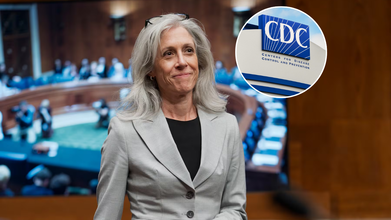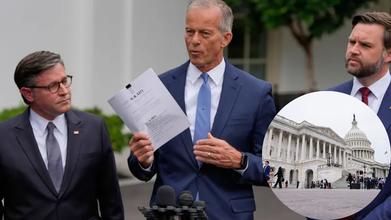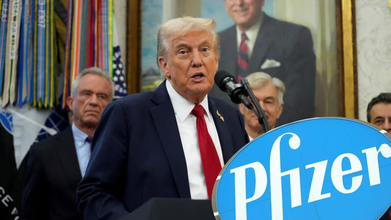- Health Conditions A-Z
- Health & Wellness
- Nutrition
- Fitness
- Health News
- Ayurveda
- Videos
- Medicine A-Z
- Parenting
- Web Stories
Who Is Susan Monarez? The New CDC Director Confirmed By The US Senate

Credits: AP/ CDC
In a closely watched vote, the U.S. Senate confirmed Dr. Susan Monarez as the new Director of the Centers for Disease Control and Prevention (CDC), marking a pivotal moment for an agency under intense political and public scrutiny. The 51-47 confirmation made Monarez the first CDC director to be Senate-confirmed under new legislation passed in 2023. The appointment follows months of leadership vacuum and ideological rifts inside the CDC that have fueled uncertainty in public health circles.
Monarez now steps into a role that has become as much about crisis management and restoring public trust as it is about public health science.
Who Is Susan Monarez?
At 50, Dr. Susan Monarez brings a formidable résumé steeped in science, biosecurity, and federal health policy. She holds a PhD in microbiology and immunology from the University of Wisconsin and completed her postdoctoral training at Stanford University. Before joining the CDC, Monarez served as Deputy Director at the Advanced Research Projects Agency for Health (ARPA-H), a government agency known for funding innovative biomedical research.
Her career spans multiple federal agencies including the Department of Homeland Security, the Health Resources and Services Administration, the Office of Science and Technology Policy at the White House, and the Biomedical Advanced Research and Development Authority (BARDA). These roles have given her deep exposure to health innovation, disaster preparedness, and pandemic response policy.
Also Read: Why Are Only Certain People At Risk Of Developing MS? World's First Study Aims To Crack The Code
Monarez has also led the development of national strategies to combat antibiotic resistance, close maternal health gaps, expand telehealth, and ensure the ethical use of health data. Her work has been consistently focused on bridging science and policy to tackle real-world health threats—both globally and domestically.
Monarez’s confirmation ends a stretch of instability at the CDC, which has been operating without a permanent director since early 2025. The agency has faced major staff losses, widespread morale issues, and increasingly vocal political pressure. President Trump’s initial nominee, David Weldon, was withdrawn unexpectedly, and Monarez was named acting director in January before being formally nominated in March.
During her confirmation hearing, Monarez maintained a diplomatic stance affirming her support for vaccines and science-based policy—while skirting direct questions about her relationship with Health Secretary Robert F. Kennedy Jr., whose controversial antivaccine positions have sparked upheaval within the agency. Kennedy has taken bold steps to sideline CDC authority, including bypassing the agency earlier this year to roll back COVID-19 vaccine guidance for pregnant women and children.
That move underscored the new reality Monarez inherits: a CDC whose power and relevance in setting public health policy is being redefined in real-time.
At her Senate hearing, Monarez was clear about her priorities: rebuilding public confidence in the CDC, modernizing outdated data infrastructure, and preparing for future infectious disease threats. These are not minor tasks. The CDC has suffered from a credibility gap over the last several years, exacerbated by mixed messaging during the COVID-19 pandemic, political interference, and what many in the public saw as a lack of transparency.
“She brings decades of distinguished experience in health innovation, disaster preparedness, global health, and biosecurity to CDC,” the agency said in a social media post following the vote. “Dr. Monarez will lead efforts to prevent disease and respond to domestic and global health threats.”
But restoring trust will take more than credentials. The CDC’s internal structure and external messaging need overhauling to match the expectations of a more skeptical and divided public. Monarez is taking over an agency in flux—both scientifically and politically.
Science and Strategy Behind the Leader
Monarez’s scientific work reflects a global and future-forward perspective. She has spent her career at the intersection of technology and health policy, especially in biodefense and medical preparedness. At ARPA-H, she helped direct funding toward tools for rapid disease detection, AI-driven health diagnostics, and innovative solutions for behavioral health and maternal care disparities.
She has also been deeply involved in policy development at the national level, helping craft presidential action plans and leading interagency coordination on issues ranging from pandemic preparedness to organ transplantation reform. In previous roles, she worked directly on combating multi-drug-resistant infections and led international collaborations with the EU, Canada, France, and others on biosecurity measures.
This blend of strategic vision and scientific rigor is exactly what public health experts say the CDC needs now—particularly in an era where emerging infectious diseases, misinformation, and technology disruptions often collide.
What’s Next for the CDC Under Monarez?
Monarez is stepping into the role amid mounting public health challenges. Vaccine skepticism is on the rise, federal funding for the CDC is set to be slashed under the 2026 budget proposal, and chronic disease burdens continue to grow alongside new threats like drug-resistant bacteria and climate-related health crises.
Her immediate task will be internal stabilization—building back teams, reaffirming scientific values, and reestablishing CDC leadership across state and local public health departments. Externally, she must walk a careful line: maintaining scientific integrity while navigating a politically volatile environment.
Already, her ability to operate in this tension-filled space is under watch. While her academic and professional pedigree earns her respect in science circles, her willingness—or reluctance—to directly challenge political directives from Secretary Kennedy and the White House will define her legacy at the CDC.
Susan Monarez’s confirmation is more than a personnel change; it signals a recalibration of how public health leadership will work in today’s polarized environment. Her track record suggests she understands the complexity and weight of the role.
The real test now is whether she can reassert the CDC’s voice in public health, without becoming another casualty in the ongoing tug-of-war between science and politics.
US Government Shutdown: What Does It Mean For Health Services?

Credits: AP
The US government shuts down at midnight confirmed Associated Press. The Vice President JD Vance said, "I think we're headed to a shutdown because the Democrats won't do the right thing," after a meeting where Congressional Democrats refused to give Republicans the votes they needed to pass a short-term funding agreement. The Democrats have demanded overhauls to Medicaid cuts and extensions to health care tax credits, something Republicans wish to stay out of.
House Minority Leader Hakeem Jeffries said that Republicans are "divorced from reality". He said, "They just wanted to kick the health care problem down the road."
What Does US Government Shutdown Mean For Health Services?
During a shutdown, only 59% of employees would be working at the Department of Health and Human Services. The rest are to be furloughed, meaning to be discharged from their job.
This means, out of the 47,257 employees who would be kept during the shutdown, only 35,000 would be continued to paid, while 12,000 would work without pay. Around 32,460 Health and Human Services (HHS) employees will be discharged from their work.
For the Centers for Disease Control and Prevention (CDC), only 36% of employees would work, with 15% without pay, also reported by ABC News. At the Food and Drug Administration (FDA), 86% employees would continue to work, with 19% without pay.
What it means for safety guidelines? The FDA's Animal Drugs and Foods Program "would end pre-market safety reviews of novel animal food ingredients for livestock, thus be unable to ensure that the meat, milk, and eggs of livestock are safe for people to eat; activities would be limited to those that address imminent threats to the safety of human life".
The National Institutes of Health would also come down to 24% of employees.
Will Medicare and Medicaid Continue During The US Government Shutdown?
Federal spending's biggest portion which is considered 'mandatory' will remain untouched, including payments by Social Security, Medicare and Medicaid.
While government officials say that payments won't be affected, related services could, however, slow down, including receiving replacement cards and benefit verification services.
This could also threaten around 7 million low-income women and their children who relied on programs like the Women, Infants. and Children (WIC), a US federal program that provides nutritious foods, nutrition education, and referrals to healthcare and social services for low-income pregnant and postpartum women, infants, and children up to the age of 5, who are at nutritional risk.
Ali Hard, who is the policy director for the National WIC Association told ABC News that if a shutdown continues for more than a week, WIC may begin to run out of funds.
Why Is The US Government Shutting Down?
The main crux of it could be the disagreement in the health policies. For the extended funding, which would only be possible through cuts in Medicaid, the Senate voted 55-45 on the measure, which has left Republicans five votes short of 60 vote threshold.
President Donald Trump on this said, "They (Democrats) want to give health care to illegal immigrants, which will destroy health care for everybody else in our country."
Previously it happened during the 2018-2019 shutdown, which lasted for 35 days.
International Day Of Older Persons 2025: Theme, Significance, and Origin

Credits: Canva
Every year on October 1, International Day of Older Persons is observed so as to raise awareness about the challenges and opportunities of ageing. The World Health Organization (WHO) notes that it is a day for honoring the contribution of older persons to society and also highlighting the importance of their dignity, independence, and inclusion.
International Day of Older Persons 2025 Theme
This year's theme advocates for healthy and inclusive aging. The United Nations (UN) Secretary-General Antonio Guterres says, "This year's theme reminds us, older persons are powerful agents of change. Their voices must be heard in shaping policies, ending age discrimination, and building inclusive societies."
UN notes that this year's theme is: Older Persons Driving Local and Global Action: Out Aspirations, Our Well Being and Our Rights.
Importance And Significance of International Day Of Older Persons
WHO notes that by 2100, the number of people aged 65 and over would reach 2.4 billion, and the fastest growing segment will be those aged 80 and older. Much of the work at the WHO Kobe Centre aims to accelerate progress toward universal health coverage (UHC) in the context of population ageing to improve the accessibility, affordability and acceptability of health services including long-term care (LTC) for older people.
Over the past year, new research was undertaken to examine unmet health and social care needs among older adults (generally above 60 years) across five of WHO’s regions. The aim was to ensure that this population is not excluded from global progress towards universal health coverage (UHC).
For the first time, policymakers have access to region-specific evidence highlighting the gaps and opportunities in care, enabling them to address barriers that lead to unmet needs. Strengthening health information systems in this way is considered vital for inclusive planning and for improving health outcomes and wellbeing among older people.
How health services are financed also plays a critical role in ensuring coverage, quality, financial protection, and overall outcomes for older populations.
Read: From Infants To Elderly: There Is No Age To Get Your Heart Checked, According To Doctors
Origin of International Day For Older Persons
It was on December 14, 1990, when the UN General Assembly designated October 1 as the International Day for Older Persons, under the resolution 45/106. This was preceded by initiatives such as the Vienna International Plan of Action on Ageing, which was adopted by the 1982 World Assembly on Ageing and endorsed later that year by the UN General Assembly.
In 1991, the General Assembly adopted the United Nations Principles for Older Persons (resolution 46/91). In 2002, the Second World Assembly on Ageing adopted the Madrid International Plan of Action on Ageing, to respond to the opportunities and challenges of population ageing in the 21st century and to promote the development of a society for all ages.
The number of older people (defined as those aged 65 years or older) tripled from around 260 million in 1980 to 761 million in 2021. Between 2021 and 2050, the global share of the older population is projected to increase from less than 10% to around 17%. Rapid growth in the number of people reaching older ages underscores the significance of promoting health, preventing, and treating illnesses throughout the entire course of life.
Trump-Pfizer Deal: What Does It Mean For Drug Prices In America?

Credits: Reuters and Pfizer
US pays more than it should for prescription medicines, a view US President Donald Trump has upheld for the longest. Reflecting on the same, Pfizer, an American multinational pharmaceutical company on Tuesday said that it had agreed to cut prices for the drugs it sells to the Medicaid program for low-income Americans and to ensure the US would not pay more for new medicines as compared to other high-income nations. In the view of this, Trump said that he hopes other drugmakers to follow the suit.
The TrumpX Website
A Reuters report note that by early next year, the US government plans to launch a website called TrumpRx. This website will help customers directly buy the drugs from manufacturer. At this moment, nearly all of the existing direct-to-consumer sales platform require patients to buy their medications out-of-pocket.
In this background, the website hopes to bring the cost down.
Price Cuts For Medicaid
Pfizer has announced plans to cut prices for most of its treatments covered by Medicaid, the federal and state health insurance program for low-income individuals and families. While the company shared few details on the timing or scale of discounts, the move comes amid growing scrutiny of drug costs in the U.S.
By law, drugmakers must already provide Medicaid with significant discounts compared to the lowest available market price. Medicaid accounts for roughly 10% of total U.S. prescription drug spending. It remains unclear whether Pfizer’s decision will extend to private insurers or other government programs such as Medicare.
Global Pricing Commitment
Pfizer also said it will introduce new medicines in the U.S. at the same price offered in other high-income countries. Research has consistently shown that American patients pay significantly more for brand-name drugs, over three times higher than consumers in other wealthy nations.
According to a Reuters report, average launch prices of new drugs in the U.S. more than doubled in 2022, reaching $370,000 compared to $180,000 the year before. Much of this increase reflects the surge in therapies for rare diseases, which typically command higher prices. Some companies have already moved toward price alignment, Bristol Myers, for instance, announced plans to launch its schizophrenia drug Cobenfy in Britain at the same price as in the U.S.
Still, uncertainty remains over whether listed prices will represent the final cost, as drugmakers often negotiate confidential rebates with governments and insurers.
Pressure on Global Markets
The Trump administration, which has supported these pricing shifts, has also signaled that it wants other countries to pay more for branded medications, a proposal that has drawn resistance from international governments. The U.S. has argued that higher overseas prices would support research and development, though global health officials remain cautious.
Trade Tariffs and U.S. Manufacturing
In a bid to avoid looming tariffs, Pfizer pledged to bring 100% of the value of its pharmaceutical imports onshore by building U.S. manufacturing capacity. Under the plan, the company will receive a three-year exemption from new tariffs targeting patented and branded drugs. Former President Donald Trump has warned that without such measures, branded pharmaceutical imports could face tariffs of up to 100% beginning October 1.
© 2024 Bennett, Coleman & Company Limited

